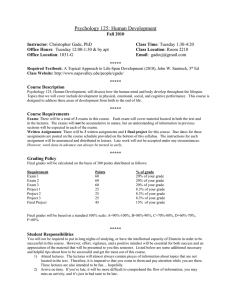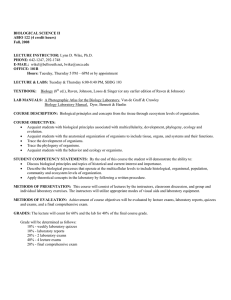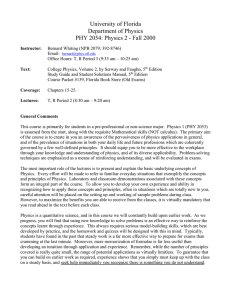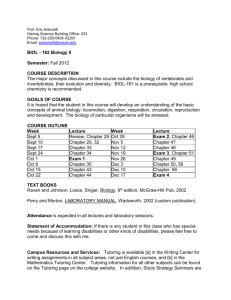BIOLOGY 26-105-A09C - BIOLOGICAL CONCEPTS:UNITY SYLLABUS Instructor
advertisement
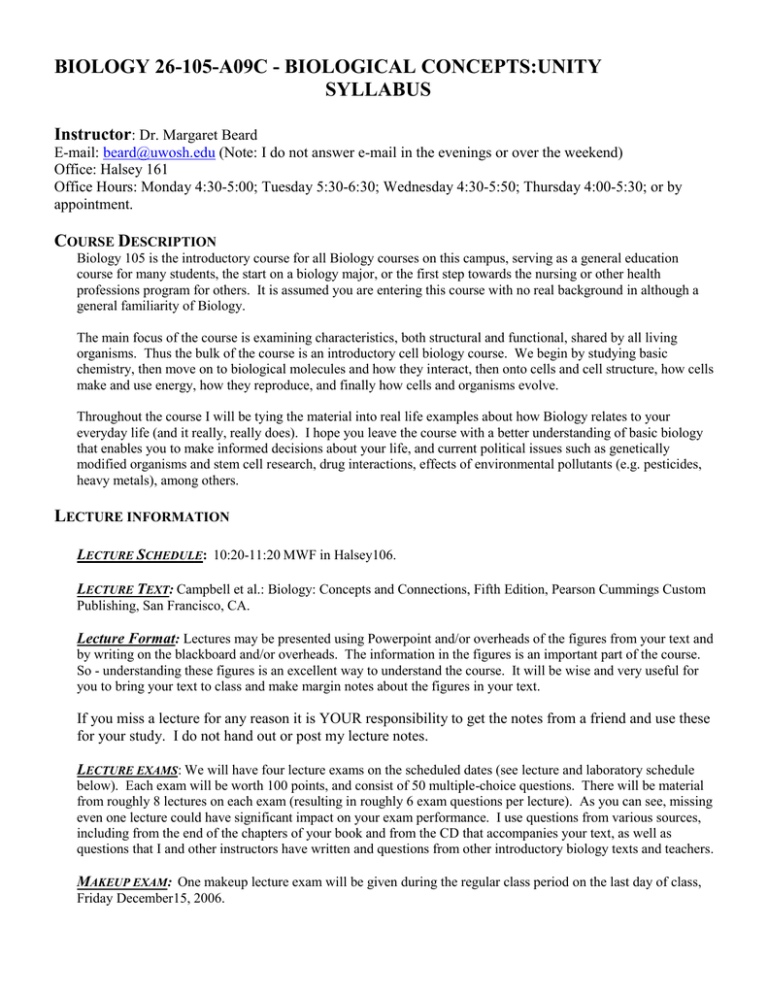
BIOLOGY 26-105-A09C - BIOLOGICAL CONCEPTS:UNITY SYLLABUS Instructor: Dr. Margaret Beard E-mail: beard@uwosh.edu (Note: I do not answer e-mail in the evenings or over the weekend) Office: Halsey 161 Office Hours: Monday 4:30-5:00; Tuesday 5:30-6:30; Wednesday 4:30-5:50; Thursday 4:00-5:30; or by appointment. COURSE DESCRIPTION Biology 105 is the introductory course for all Biology courses on this campus, serving as a general education course for many students, the start on a biology major, or the first step towards the nursing or other health professions program for others. It is assumed you are entering this course with no real background in although a general familiarity of Biology. The main focus of the course is examining characteristics, both structural and functional, shared by all living organisms. Thus the bulk of the course is an introductory cell biology course. We begin by studying basic chemistry, then move on to biological molecules and how they interact, then onto cells and cell structure, how cells make and use energy, how they reproduce, and finally how cells and organisms evolve. Throughout the course I will be tying the material into real life examples about how Biology relates to your everyday life (and it really, really does). I hope you leave the course with a better understanding of basic biology that enables you to make informed decisions about your life, and current political issues such as genetically modified organisms and stem cell research, drug interactions, effects of environmental pollutants (e.g. pesticides, heavy metals), among others. LECTURE INFORMATION LECTURE SCHEDULE: 10:20-11:20 MWF in Halsey106. LECTURE TEXT: Campbell et al.: Biology: Concepts and Connections, Fifth Edition, Pearson Cummings Custom Publishing, San Francisco, CA. Lecture Format: Lectures may be presented using Powerpoint and/or overheads of the figures from your text and by writing on the blackboard and/or overheads. The information in the figures is an important part of the course. So - understanding these figures is an excellent way to understand the course. It will be wise and very useful for you to bring your text to class and make margin notes about the figures in your text. If you miss a lecture for any reason it is YOUR responsibility to get the notes from a friend and use these for your study. I do not hand out or post my lecture notes. LECTURE EXAMS: We will have four lecture exams on the scheduled dates (see lecture and laboratory schedule below). Each exam will be worth 100 points, and consist of 50 multiple-choice questions. There will be material from roughly 8 lectures on each exam (resulting in roughly 6 exam questions per lecture). As you can see, missing even one lecture could have significant impact on your exam performance. I use questions from various sources, including from the end of the chapters of your book and from the CD that accompanies your text, as well as questions that I and other instructors have written and questions from other introductory biology texts and teachers. MAKEUP EXAM: One makeup lecture exam will be given during the regular class period on the last day of class, Friday December15, 2006. The make-up exam can be taken only by individuals who miss the regularly scheduled lecture or a lab exam for an approved reason. Approved reasons for missing an exam are: (1) a documented university sponsored event that conflicts with the exam date; (2) a family crisis (e.g. your illness documented by health service notice or doctor’s note; a serious illness of a parent documented; a death in your immediate family – parents or siblings or grandparents but not cousins etc that is documented by an obituary notice). I do not allow your taking the make-up exam for reasons such as – I have purchased airline tickets already or I am participating in a wedding. Read the class schedule carefully and make your plans accordingly The make-up exam will be comprehensive (covering material from any and all prior exams). In order to be eligible to take this exam, a student must receive prior permission from Dr. Beard and permission will be granted only for those who contacted Dr. Beard before the exam missed. Only one missed exam score (EITHER LECTURE OR LAB) may be replaced with the makeup exam score-so if you miss more than one exam, or you do not contact Dr. Beard before a missed exam, you will not be allowed to take the make-up exam. EXAM REGRADE POLICY Exams will be entirely multiple choice – thought provoking nevertheless. Grading errors on exams do occur. These may be as simple as an addition error; or more encompassing, such as my misinterpretation or your use of a source different from the text or other assigned reading with information different from the expected answer to a question. In either case I will ONLY accept requests for re-grades when submitted in writing and within 48 hours of your having received the test back. In your written request you MUST JUSTIFY WHY you believe that your answer is correct – i.e. provide the outside source, explain your logic, etc. Note: if the request is for a simply addition error, this needs no justification. WHENEVER A REGRADE IS REQUESTED, I RESERVE THE RIGHT TO REGRADE THE ENTIRE EXAM, NOT ONLY THE QUESTION(S) AT ISSUE. LABORATORY INFORMATION Laboratory meeting times: There are seven lab sections, A01-A07 that correspond to this lecture. You need to attend the lab section you are signed into as space is limited. Labs will meet each week at the assigned time in Room 211 and be two hours in length-assume each lab will take the entire period. You will receive a lab syllabus from your lab instructor with more details on how your lab section will be conducted. Labs cannot be made-up as there is extensive preparation necessary by our staff for each lab. LABORATORY TEXT: Holton and Charley-Johnson: BIO 105: Concepts in Biology: Unity: Laboratory Manual. Bring it (along with lecture text) to every laboratory meeting. LABORATORY EXAMS: Three laboratory exams (worth 100 pts each) will be administered during lecture periods (see lecture and laboratory schedule). Lab exams will consist of 40-50 multiple-choice questions. A missed exam will result in a score of zero for that exam, unless you qualify for the makeup exam (see above). LABORATORY GRADE: You will have 400 points from the lab-300 points from the lab exams and 100 points that will be assigned by your lab instructor. GRADING COURSE GRADE: There are a total of 800 points possible for the semester (400 points from lecture exams, 300 points from lab exams, and 100 points from lab). I will calculate your grade by dividing the total number of points you earn over the semester by 800, which will yield a percentage. This percentage will be converted into a letter grade using the scale below: GRADING SCALE: (Note: I reserve the right to lower the scale slightly if class performance warrants such a change.) 100-90% = A 89%-87% = AB 86-80% = B 79-77% = BC 76-70% = C 69-67% = CD 66-60% = D <60% = F CHEATING POLICY: Cheating of any kind will not be tolerated. It will result in an F grade in the class and possible expulsion from the University. STATEMENT ON ACADEMIC DISHONESTY: Any evidence of any form of academic dishonesty makes you subject to the Student Academic Disciplinary Procedures, as outlined in the University of Wisconsin Oshkosh Student Discipline Code, as detailed in specific provisions of Chapter 14 of the State of Wisconsin Administrative Code. (http://www/uwosh.edu/dean). Any student found in violation of any aspect of the above Code will receive a sanction as detailed in UWS 14.005 & 14.06, ranging from a grade of zero on the assignment to expulsion from the university. . Academic dishonesty is interpreted to include (but is not limited to) the following: looking at another student’s exam and/or copying answers, talking to other students in exams; using notes or other resources e.g. electronic devices during exams, when not permitted, using another’s work (obtained from on campus or off campus sources) as a student’s own; not giving attribution to work either quoted or paraphrased, failure to give sources for work referenced, etc. Students may appeal sanctions per UWS 14.06-14.08. ATTENDANCE – I do not regularly take attendance in lecture. Attending lecture and developing good note-taking skills will increase your doing well in the course. I will not repeat any lectures nor will I publish any of my notes. Your attendance in laboratory is requires. You must attend lab section in which you are enrolled and which corresponds to the lecture section in which you are enrolled. If you know that you will miss your regularly scheduled lab, you can try to arrange to attend a different lab section that week. To do this you contact the instructor for the lab you wish to attend and confirm that you may participate in his/her lab section. You then must also notify your regular lab instructor. Lab instructors are under no obligation to allow you into their lab. . LABORATORY INSTRUCTORS: The table below lists instructors for my lab sections and all of the other lab sections that they teach. Note: Dr. Beard is lecturer for A01-A07 and D01-D05; Dr. Holton is lecturer for for B01-B07; and Dr. Lammers is lecturer for C01-C07. YOU MUST ATTEND THE LECTURES THAT CORRESPOND WITH YOUR LABORATORY SECTION, (e.g. if you enroll for lab sections A01L-A07L, you must attend Dr.Beard’s lectures…. not attend Drs. Holton’s or Lammers’ lectures.) Name Mr. Bosma Ms. Charley-Johnson Ms. Davis-Foust Dr. Dorn Section # A01L, A03L, B02L, B05L, B06L, C06L A02L, A04L, A05L, B01L, B07L, C04L B04L, C02L, D01L, D02L, D04L B03L Phone 0930 3064 Office HS39 HS33 HS157 HS44 LECTURE AND LABORATORY SCHEDULE Date Lecture Topic Sept 6 Sept 11 Introduction; Overview of Science and Biology,Initial Assessment Exam Basic Chemistry: Elements, Atoms, and Bonds Water, Chemical Reactions Sept 13 Molecules 3.1-3.7 Sept 15 Sept 18 Molecules Introduction to Cells 3.8-3.16 4.1-4.5 Sept 20 Organelles 4.6-4.12 Sept 22 Sept 25 Organelles Energy and Enzymes 4.13-4.19 5.1-5.9 Sept 27 Sept 29 Oct 2 Membrane structure and function Transport and Osmosis Cell Respiration I 5.10-5.14 5.15-5.21 6.1-6.6 Oct 4 Oct 6 Oct 9 Cellular Respiration II Lecture Exam I (covers thru 9/29) Cellular Respiration III 6.7-6.12 Oct 11 Oct 13 Photosynthesis I Lab Exam I ( covers labs 1-4) 7.1-7.4 Oct 16 Photosynthesis II 7.5-7.9 Oct 18 Oct 20 Photosynthesis III Cell Division - Cell Cycle, Mitosis, Cytokinesis 7.10-7.14 8.1-8.11 Oct 23 Cell Cycle, Mitosis, Cytokinesis cont. ditto Oct 25 Oct 27 Cancer, Prokaryotic Cell Division Lecture Exam II (covers thru 10/18) ditto Sept 8 Text Reading 1 Lab Topics/Related Text Readings No lab this week 2.1-2.9 2.10-2.17 6.13-6.16 Exercise 1: Being a scientist/Chap1:esp 1.7-1.8 Exercise 2: Infectious disease; start Exercise 3: Mystical Molecules/ Chap 3 Continue Exercise 2; Finish Exercise 3 Finish Exercise 2; Exercise 4: Enzymes/ Chap 5.5-5.9 Exercise 5: Osmosis and diffusion/ 5.14-5.16 Exercise 6: Respiration/ Chap 6 Exercise 7: Photosynthesis/Chap 7 Oct 30 Meiosis I 8.12-8.25 Nov 1 Meiosis II 8.16-8.23 Nov 3 Lab Exam II (covers labs 5,6,7) Nov 6 Mendelian Genetics I; 9.1-9.7 Nov 8 Nov 10 Mendelian Genetics II Mendelian Genetics III 9.18-9.24 9.8-9.17 Nov 13 Nov 15 Nov 17 DNA I DNA II Transcription and translation 10.1-10.8 ditto 10.6-10.16 Nov 20 Nov 22 Regulation of transcription and translation 11.1-11.8 Lecture Exam III (covers thru 11/17)Gene Function/Gene Expression Nov 27 Nov 29 Transcription and Translation Evolution I: 10.9-10.17 13.1-13.5 Finish Exercise 9; Dec 1 Evolution II 13.6-13.18 Exercises 10: A Quick Exercise in Selection/ Chap 12; Exercise 11: Speciesproducts of evolution Chaps 13-15 Dec 4 Evolution III 14.1-14.13; parts of 15 and 16 Dec 6 Wrap -Up Dec 6 Dec 11 Dec 13 Dec 15 Lab Exam III (labs 8,9, 10, and 11) Lecture Exam IV (covers thru 12/6) Make-up Exam (comprehensive) * * Exercises 8: Two defectsdid one cause the other?/ Chap 9 & Exercise 9:The first steps in genetic engineering/ Chap 12.112.3 Continue Exercise 9 Continue Exercises 8 and 9 No Labs STUDY/REVIEW SESSIONS: Study sessions before LECTURE exams will be held on dates/times Oct. 5, Oct. 25, Nov. 20, Dec. 12 from 5:30-7 in HS 106. Study Sessions for LAB exams will be held on dates/times : Oct 12, Nov 2, Dec. 8 from 5:30-7:00 in HS 106. TO HELP YOU IN YOUR PROCESS OF LEARNING: 1) SUPPLEMENTAL INSTRUCTION (SI) for Biology 105-A09C – BEARD SI Leader: Aaron Burg - burga05@uwosh.edu What is SI? Supplemental Instruction (SI) is a series of weekly review sessions for students taking historically difficult courses. SI is provided for all students who want to improve their understanding of course material and improve their grades with an emphasis on learning how to study and how to learn. Attendance at SI sessions is voluntary. For you the student, it’s a chance to get together with people in your class to compare notes, to discuss important concepts, to develop strategies for studying the subject, and to test yourselves before your professor does. At each session you will be guided through this material by your SI leader, a competent student who has previously taken the course. What is an SI leader? Have you ever wished you could do something over, knowing what you know now? SI leaders are students themselves and are prepared to share with you what they have learned over the years about how to study. They know the course content and are anxious to help guide you through it. They’ll be in class with you every day, hearing what you hear and reading what you read. What they won’t do is lecture; their job is to help you think about the lectures you hear and the books you read, and then put it altogether during the SI review sessions. SI can help you learn course material more efficiently. When do SI review sessions start? On the first day of class you will fill out a short survey to let the SI leader know your class schedule. Each SI leader will set up two or three review sessions each week at times that are best for the majority of students taking the class. You can attend one, two, or all three (the choice is yours) and each one will be different because you’ll have new material to discuss. SI review sessions are informal. Bring your notes; bring your textbook; bring your questions. What’s in it for me? If you attend SI sessions regularly, chances are you’ll earn a better grade. You’ll have developed a better understanding of course content as well as more effective ways of studying. This will help you in other classes also. 2) BIOLOGY 105 TUTOR – tba 3) TIPS FOR SUCCESS IN BIOLOGY 105 What follows are some tried and true strategies for achieving the highest possible grade in biology (and actually in almost any course. 1. Attend class and take notes!! Learning is a process that uses as many senses as possible –eyes, ears and hand (touch) 2. Scan the assigned reading BEFORE coming to lecture (or lab) so that you have some familiarity with the words and concepts to be discussed that day. You will be able to think about the information being presented with less stress. 3. After lecture copy over your lecture notes, using you own words to describe a topic not my words that you took down in class. You will forget my words very easily, your words less easily. It is a documented fact that repetition and rehearsal are the means to memory. 4. Now also is the time to re-read the text, underlining specifically those words and phrases that augment and amplify your notes. You might find it useful to insert ideas from the text into you lecture notes. 5. Lecture exam question are based on material presented in the lecture period AND in the text. (Lab exam question are based on material presented in the laboratory and relevant material presented in lecture). When putting together an exam, I start by going back to my lecture notes and picking out concepts that are important. If a concept is important enough to have been in a lecture it is important enough to be on a test. Sometimes, a test question will come from a single sentence mentioned in lecture. So – Pay Attention!! No test question will come solely from information in the text. While most test question will be straightforward – Do you know a fact about something - others will ask you to apply facts or to tie concepts together. You can memorize answers to questions in the first style but not to the last styles. These require that you have thought about the topics studied. 6. It may be very useful for you to ask and answer the following questions about each of the topic headings and bold-face words in your text. What does the word or concept mean? (Define the word/concept) Where is the word/concept found? When is the word/concept used or operating Why is the word/concept needed (i.e. what is it doing? why is it important)? How is the word/concept regulated (turned on or off) in the biological world? 7. Ask questions – of me, of you lab instructors, of you SI leader, of the biology tutor and of you fellow students. 8. Answer questions. Form study groups and talk to each other. The best indicator of whether you understand information is if you can teach it to someone else!! 4) HINTS FOR STUDYING FOR EXAMS – 1. BE ABLE TO DISCUSS THE BOLD FACE WORDS AND THE TOPIC HEADINGS IN YOUR TEXT, BY ANSWERING THE QUESTIONS “WHAT DOES THE WORD OR TOPIC MEAN TO BIOLOGY?; WHEN IS THE WORD OR TOPIC IMPORTANT IN BIOLOGY I.E. HOW DOES IT FUNCTION OR WORK”. 2. USE THE CHAPTER REVIEW IN YOUR TEXT 3. STUDY THE THOUGHT QUESTIONS INTERSPERSED THROUGHT THE CHAPTERS 4. USE THE CD AND WEB SITE 5. WORK WITH A STUDY PARTNER – TALK ABOUT THE TOPICS. (IF YOU CAN TEACH A CONCEPT OR THE MEANING OF A PHRASE OR WORD TO SOMEONE ELSE YOU KNOW IT. 6. LOOK AT THE EXAM THAT IS POSTED IN D2L FOR STYLE – YES YOU CAN STUDY THESE QUESTIONS TOO; HOWEVER THERE IS NO ASSURANCE THAT THEY WILL APPEAR ON ANY EXAM. 7. STUDY THE KEY WORD AND CONCEPT STUDY GUIDE POSTED IN D2L I will be available to answer questions and to review during an evening (generally 5:30-7pm) before each of the 7 exams (lecture and lab).
